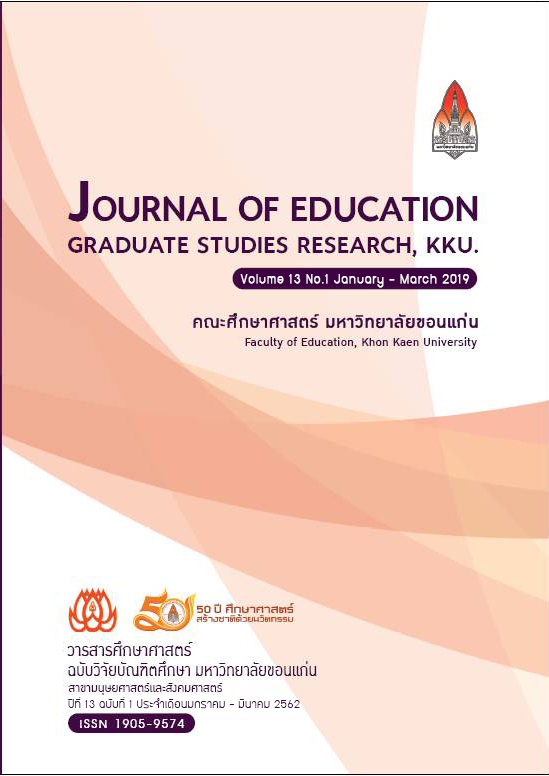Thai Dramatic Arts Camp for Excellence by Using Direct Instruction Model for Senior High School Students
Main Article Content
Abstract
This research aims to 1) develop the curriculum of dancing skill development camp towards excellence of Thai dramatic arts, 2) study Thai dramatic arts skill of senior high school students after join of development of Thai dramatic arts camp for excellence and 3) study the students’ satisfaction in the development of Thai dramatic arts camp for excellence. This is considered the pre-experimental research with the one-shot case study. The target group is six senior high school students in the Club of Thai Dramatic Arts, Petpittayakom School, Petchabun Province. The tools used in this research were 1) the learning plan of the curriculum of development of Thai dramatic arts camp for excellence comprising of 14 teaching plans for 54 hours in total, 2) the evaluation form of Thai dramatic arts skill, and 3) the evaluation form pertaining to students’ satisfaction. The research findings revealed that:
- 1. The curriculum of dancing skill development camp towards excellence of Thai dramatic arts used the direct instruction model comprising of as follows:
1.1 The objectives of curriculum were that the students could memorize a posture of basic vocabularies of Thai dramatic arts, memorize dancing postures while music was played, danced along rhythm and lyrics themselves, make their dancing styles, join a camp of basic improvement of Thai dramatic arts with happiness, comprehend the dancing base, appreciate and be proud of Thai dramatic arts;
1.2 The contents in the curriculum included basic training (bending body, fingers and arms and taking short steps), dancing posture follow, design of facial art, make-up training for performances and standing posture training of actors and actress;
1.3 The learning activities included the learning management plan by the use of direct instruction model divided into 14 plans for 54 hours in total;
1.4 The measurement and evaluation included evaluation of Thai dancing skills and evaluation of the students’ satisfaction;
- 2. The students’ skill was at an excellent level (considered 85 percent), and all of the students passed the criteria as determined and
- 3. The satisfaction of holding the camp of Thai dramatic arts skill development towards excellence was at an maximum level (x̄ = 4.17, S.D. = 15).
Article Details
References
กระทรวงศึกษาธิการ, กรมวิชาการ. 2551. หลักสูตรการศึกษาขั้นพื้นฐาน พุทธศักราช 2551. กรุงเทพฯ: พัฒนาคุณภาพวิชาการ (พว).
ธนัญชัย มณีธรรม. (2547). ปัญหาการใช้หลักสูตรสถานศึกษาของโรงเรียนนำร่องและโรงเรียนเครือข่าย สังกัดกรุงเทพมหานคร. วิทยานิพนธ์ปริญญาศึกษาศาสตรมหาบัณฑิต สาขาวิชาการบริหารการศึกษา บัณฑิตวิทยาลัย มหาวิทยาลัยเกษตรศาสตร์.
นพดล สายจันทร์. (2557). การพัฒนาหลักสูตรการจัดค่ายศิลปะ ของนักเรียนระดับชั้นประถมศึกษาปีที่ 6. วิทยานิพนธ์ปริญญาศึกษาศาสตรมหาบัณฑิต สาขาวิชาหลักสูตรและการสอน บัณฑิตวิทยาลัย มหาวิทยาลัยขอนแก่น.
มาตรฐาน ศรีเงิน. (2555). ผลการจัดการเรียนรู้สาระทัศนศิลป์ เรื่อง การวาดภาพทิวทัศน์ด้วยสีน้ำของนักเรียนชั้นมัธยมศึกษาปีที่ 1 โดยใช้รูปแบบการสอนทางตรง. การศึกษาอิสระปริญญาศึกษามหาบัณฑิต มหาวิทยาลัยขอนแก่น.
วัชรินทร์ ศรีรักษา และคณะ. (2555). รายงานการวิจัย เรื่องความคิดเห็นของนักเรียนที่มีต่อการดำเนินโครงการค่ายศิลปะ (Art Camp) ของนักเรียนสาธิตมหาวิทยาลัยขอนแก่น ประจำปีการศึกษา 2555. ขอนแก่น: โรงเรียนสาธิตมหาวิทยาลัยขอนแก่น (ศึกษาศาสตร์).
วิจารณ์ พานิช. (2558). วิถีสร้างการเรียนรู้เพื่อศิษย์ ในศตวรรษที่ 21. วารสารนวัตกรรมการเรียนรู้ มหาวิทยาลัยวลัยลักษณ์, (2), 3-14.

